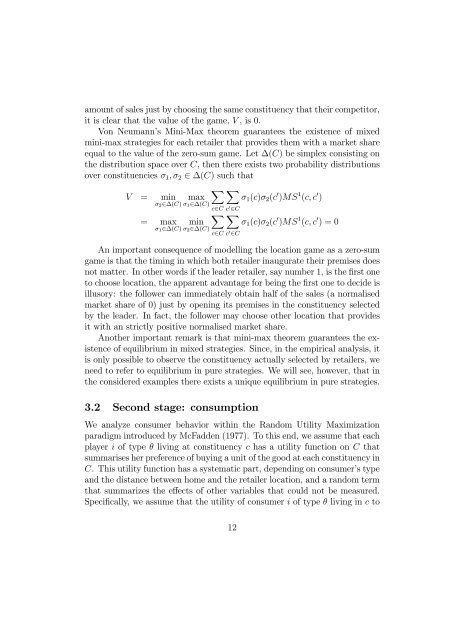Download PDF - Ivie
Create successful ePaper yourself
Turn your PDF publications into a flip-book with our unique Google optimized e-Paper software.
amount of sales just by choosing the same constituency that their competitor,<br />
it is clear that the value of the game, V ,is0.<br />
Von Neumann’s Mini-Max theorem guarantees the existence of mixed<br />
mini-max strategies for each retailer that provides them with a market share<br />
equal to the value of the zero-sum game. Let ∆(C) be simplex consisting on<br />
the distribution space over C, then there exists two probability distributions<br />
over constituencies σ 1 , σ 2 ∈ ∆(C) such that<br />
<br />
V = min max σ 1 (c)σ 2 (c )MS 1 (c, c )<br />
σ 2 ∈∆(C) σ 1 ∈∆(C)<br />
c∈C c ∈C<br />
= max<br />
min<br />
σ 1 ∈∆(C) σ 2 ∈∆(C)<br />
c∈C c ∈C<br />
<br />
σ 1 (c)σ 2 (c )MS 1 (c, c )=0<br />
An important consequence of modelling the location game as a zero-sum<br />
game is that the timing in which both retailer inaugurate their premises does<br />
not matter. In other words if the leader retailer, say number 1, is the first one<br />
to choose location, the apparent advantage for being the first one to decide is<br />
illusory: the follower can immediately obtain half of the sales (a normalised<br />
market share of 0) just by opening its premises in the constituency selected<br />
by the leader. In fact, the follower may choose other location that provides<br />
it with an strictly positive normalised market share.<br />
Another important remark is that mini-max theorem guarantees the existence<br />
of equilibrium in mixed strategies. Since, in the empirical analysis, it<br />
is only possible to observe the constituency actually selected by retailers, we<br />
need to refer to equilibrium in pure strategies. We will see, however, that in<br />
the considered examples there exists a unique equilibrium in pure strategies.<br />
3.2 Second stage: consumption<br />
We analyze consumer behavior within the Random Utility Maximization<br />
paradigm introduced by McFadden (1977). To this end, we assume that each<br />
player i of type θ living at constituency c has a utility function on C that<br />
summarises her preference of buying a unit of the good at each constituency in<br />
C. This utility function has a systematic part, depending on consumer’s type<br />
and the distance between home and the retailer location, and a random term<br />
that summarizes the effects of other variables that could not be measured.<br />
Specifically, we assume that the utility of consumer i of type θ living in c to<br />
12
















